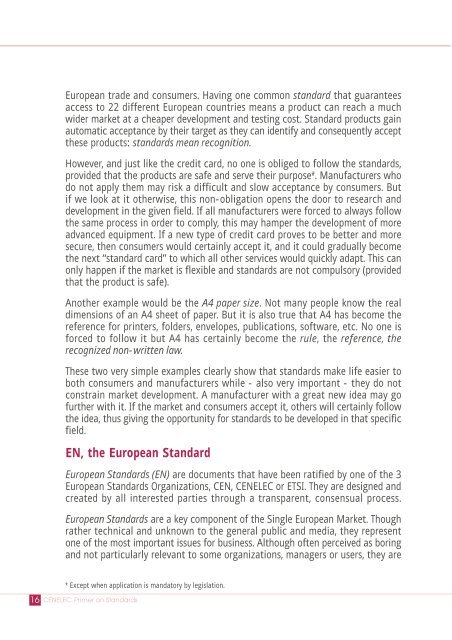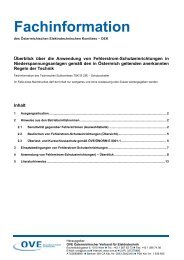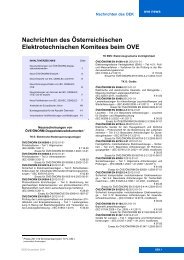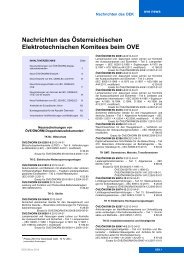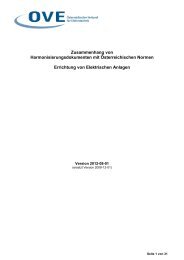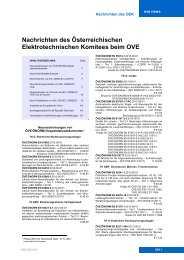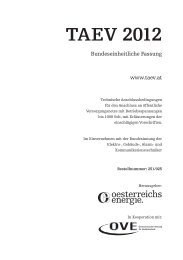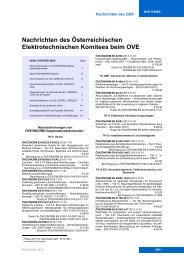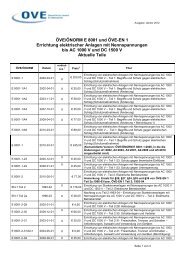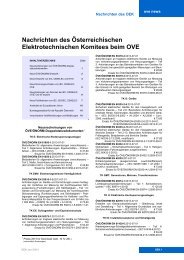Primer on Standards - OEK - OVE
Primer on Standards - OEK - OVE
Primer on Standards - OEK - OVE
- No tags were found...
Create successful ePaper yourself
Turn your PDF publications into a flip-book with our unique Google optimized e-Paper software.
European trade and c<strong>on</strong>sumers. Having <strong>on</strong>e comm<strong>on</strong> standard that guaranteesaccess to 22 different European countries means a product can reach a muchwider market at a cheaper development and testing cost. Standard products gainautomatic acceptance by their target as they can identify and c<strong>on</strong>sequently acceptthese products: standards mean recogniti<strong>on</strong>.However, and just like the credit card, no <strong>on</strong>e is obliged to follow the standards,provided that the products are safe and serve their purpose*. Manufacturers whodo not apply them may risk a difficult and slow acceptance by c<strong>on</strong>sumers. Butif we look at it otherwise, this n<strong>on</strong>-obligati<strong>on</strong> opens the door to research anddevelopment in the given field. If all manufacturers were forced to always followthe same process in order to comply, this may hamper the development of moreadvanced equipment. If a new type of credit card proves to be better and moresecure, then c<strong>on</strong>sumers would certainly accept it, and it could gradually becomethe next “standard card” to which all other services would quickly adapt. This can<strong>on</strong>ly happen if the market is flexible and standards are not compulsory (providedthat the product is safe).Another example would be the A4 paper size. Not many people know the realdimensi<strong>on</strong>s of an A4 sheet of paper. But it is also true that A4 has become thereference for printers, folders, envelopes, publicati<strong>on</strong>s, software, etc. No <strong>on</strong>e isforced to follow it but A4 has certainly become the rule, the reference, therecognized n<strong>on</strong>-written law.These two very simple examples clearly show that standards make life easier toboth c<strong>on</strong>sumers and manufacturers while - also very important - they do notc<strong>on</strong>strain market development. A manufacturer with a great new idea may gofurther with it. If the market and c<strong>on</strong>sumers accept it, others will certainly followthe idea, thus giving the opportunity for standards to be developed in that specificfield.EN, the European StandardEuropean <strong>Standards</strong> (EN) are documents that have been ratified by <strong>on</strong>e of the 3European <strong>Standards</strong> Organizati<strong>on</strong>s, CEN, CENELEC or ETSI. They are designed andcreated by all interested parties through a transparent, c<strong>on</strong>sensual process.European <strong>Standards</strong> are a key comp<strong>on</strong>ent of the Single European Market. Thoughrather technical and unknown to the general public and media, they represent<strong>on</strong>e of the most important issues for business. Although often perceived as boringand not particularly relevant to some organizati<strong>on</strong>s, managers or users, they are* Except when applicati<strong>on</strong> is mandatory by legislati<strong>on</strong>.16 CENELEC. <str<strong>on</strong>g>Primer</str<strong>on</strong>g> <strong>on</strong> <strong>Standards</strong>


